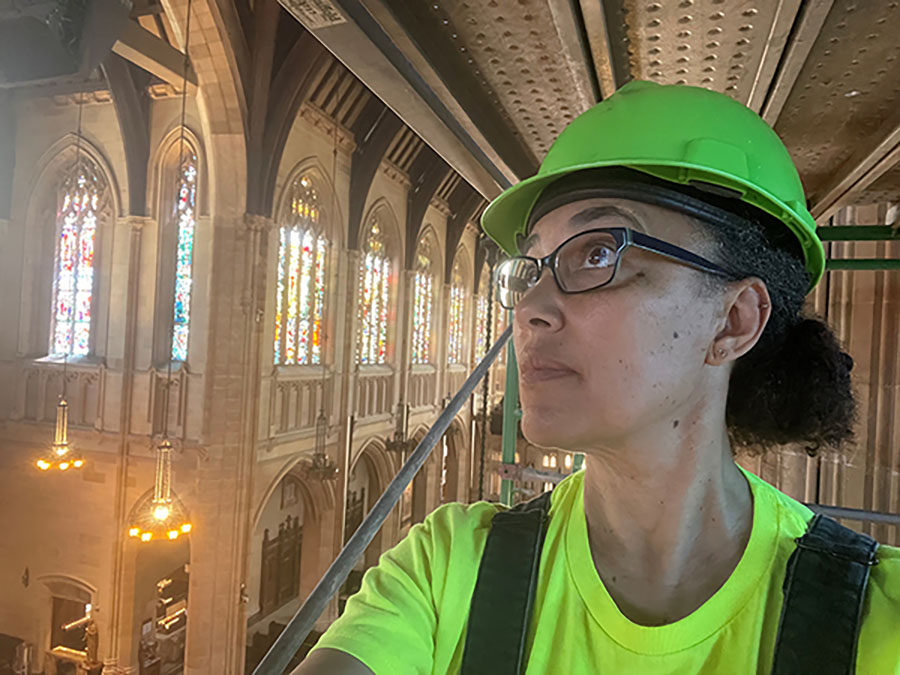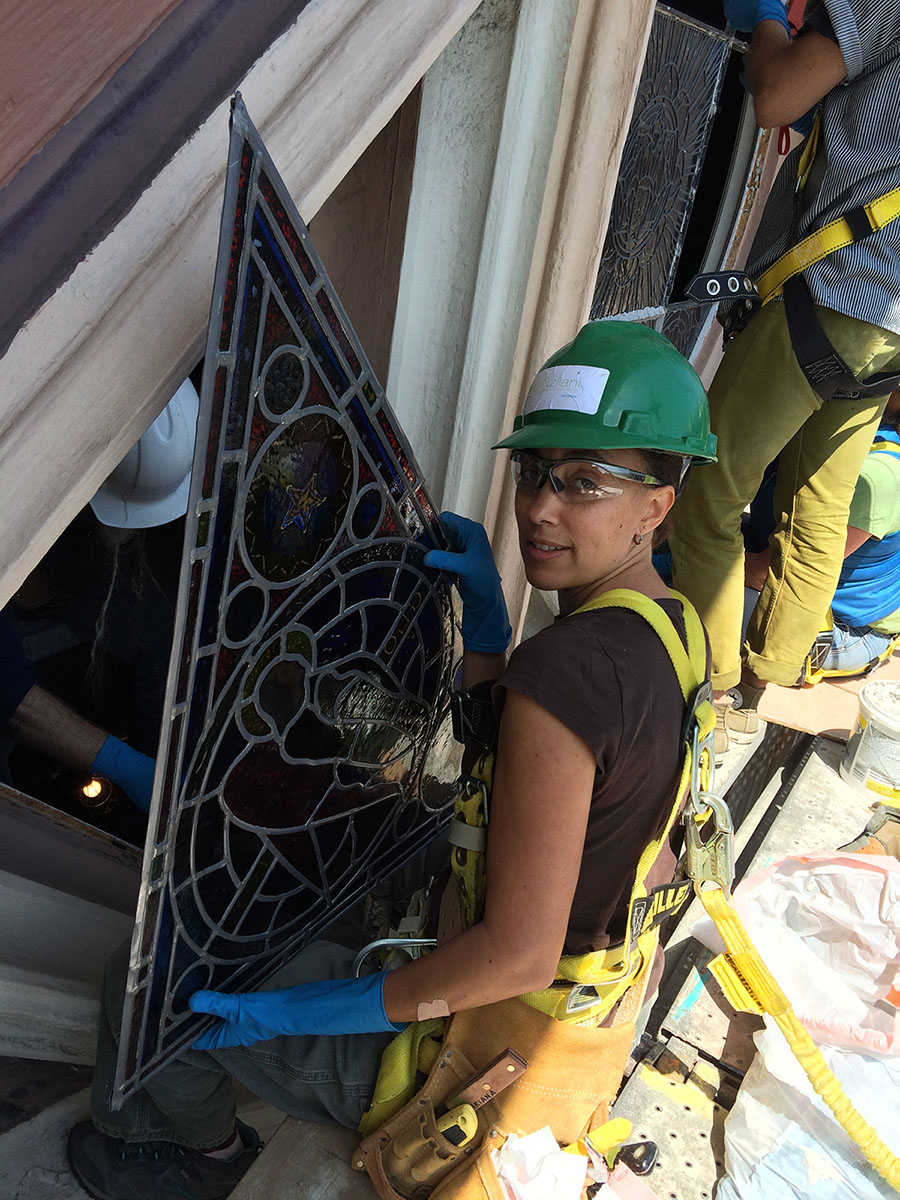
Ariana Makau, Stained Glass Conservator, Oakland, CA
Ariana Makau founded Nzilani Glass Conservation in 2003 and is its principal conservator. She has an MA in Stained Glass Conservation from the V&A/RCA, in London, England; and has been involved in preservation for 30 years. Ms. Makau is also the executive director of The Fillet Foundation which she founded in 2025. Her work experience spans numerous museums in the US and abroad including the V&A, the Met, SFMoMA, and Getty Museum. She has served on the board of the Stained Glass Association of America (SGAA), is a Fellow of the American Institute for Conservation (AIC), and a current board member of the Western Chapter of the Association of Preservation Technology (APT). As the Interim Collections C.A.R.E. Director of Destination Crenshaw (DC) from 2023-2024, Ms. Makau ensured Southern California conservators were ready for future conservation efforts involving interns, documenting public art pieces as they are installed (ensuring their ongoing maintenance is considered from day one), and creating a framework for workforce development opportunities under the umbrella of “art preservation” to be highlighted for the next generation. She finds her work is most fulfilling when at the intersection of equity, preservation, and art.
What led you to your field?
I have been interested in architecture since I was a child as well as “traditional” art mediums like paint, drawing, and textiles. I have an undergraduate degree in Studio Art after which I did a summer internship in antiquities conservation. By then, I was passionate about stained glass and earned an MA in stained glass conservation in London. Seeing stained glass in historic buildings there brought me full circle to appreciating stained glass as both an art object and a piece of architecture. It was a natural progression to start my company a few years later where I could incorporate both in what I do on a daily basis.
How does what you do relate to historic preservation?
My work at Nzilani and The Fillet Foundation directly relate to historic preservation. The former preserves stained glass to be appreciated by current and future generations while still preserving the past with extensive documentation reports, which contextualize the windows within their original building (or new location if they have been repurposed). The latter approaches history through the context of people and place. We strive to inform and include folks in the preservation process by sharing how different people in the preservation fields actively do it.
Why do you think historic preservation matters?
Now more than ever, the speed of information, the context within which it is presented, and who/how it is presented risks missing huge parts of our shared history. We must actively strive to gather data from primary sources and places before they get lost over time and their stories get retold by others. This is applicable to buildings as well as people.
What courses do you recommend for students interested in this field?
There is not a place in the US currently where someone can get a master's degree in stained glass conservation. But, there are studios who are willing to take on apprentices or interns. Taking courses in historic building trades and local stained glass classes can also be helpful. The Fillet Foundation hopes to provide courses both in person and online in the near future focusing specifically on stained glass conservation. Nzilani Glass has a YouTube channel that has a few documentary videos that will introduce folks to what we do.
Do you have a favorite preservation project? What about it made it special?

Truly, every project that we have is our favorite while we are working on them. Even though it’s the same medium, each one has unique characteristics that make them interesting. My favorite projects are the ones that are more challenging with lots of problem solving, or those that require collaborating with other specialists in the trades. Recently, we had one that required us project managing engineers, architectural metalsmiths, historians, and a rigger who usually worked for large scale public art events.
Can you tell us what you are working on right now?
We have a piece from the 1880s that is part of an old logging town–all the lead was painted gold. Also in the studio is a multi-panel Tiffany Studios window set in an original hollow core steel frame with brass stops and a few glass objects including a set of clear glass F & C Osler Sconces from the 1890s that we had to conserve as well as refabricate missing parts.
How do you think national historic preservation programs help your community?
National historic preservation programs support and encourage people to look at their own surroundings and value them–history isn’t just from a long time ago. We are making history every day. By highlighting places throughout the country, they become a piece of our collective history.
Do you have any advice for novice preservationists?
Know that there are many avenues to enter the preservation field. As long as you are curious, there is a place for you. Interview people who have a job similar to what you think you might want to focus on. Even if it isn’t exactly what you want to pursue, you can gain insight into the preservation community. Learning what you DON’T want to do is as important as discovering what you DO want to do.
The ACHP’s mission is “preserving America’s heritage;” can you give us an example of how your community is preserving its heritage?
Oakland has a rich, diverse, and long history going back to the Ohlone People. Nzilani and The Fillet Foundation are based in West Oakland which in its recent history has been a Black neighborhood. There are Black Panther murals reminding folks how they supported their community with food, childcare, and supported strong women at a time when that wasn’t always popular. Both Nzilani and The Fillet Foundation strive to support our neighbors by listening to their stories and helping them take care of their buildings/homes by sharing our experience in window and building preservation.
What is your favorite part of the conservation process?
Honestly, all of it. The start of every project is like meeting a new, fascinating person. The middle is such a gift because you get to spend time really getting to know an object or place more than any passerby would. The end is bittersweet, but you know you’re leaving the place in a better state than when you started–and have hopefully highlighted its importance with more people along the way.
What do you think the arts bring to the field of historic preservation?
For me there is no distinction between the two. We approach it full STEAM (science, technology, engineering, art, and math) ahead. In our work, you have to think like the original artist and have the capacity to replicate any missing areas. The preservation part is understanding the architectural needs of the windows (their structural needs, how they fit into the building and how all the materials interact together to prolong their longevity). Knowing how to replicate elements, but not invent areas that don’t have any historic references like drawings, photographs or written descriptions, is also key.
Do you have any projects you are looking forward to in the future?
I look forward to being at the helm of Nzilani as we continue to conserve unique leaded art glass. At the same time, I’m laser focused on expanding The Fillet Foundation to serve more people in the Bay Area and beyond. We hope to have interns, outreach to schools, and eventually host preservation specialist talks at our studio who can share their expertise with a wider community.
Read more Q&A stories about the Preservationists in Your Neighborhood!